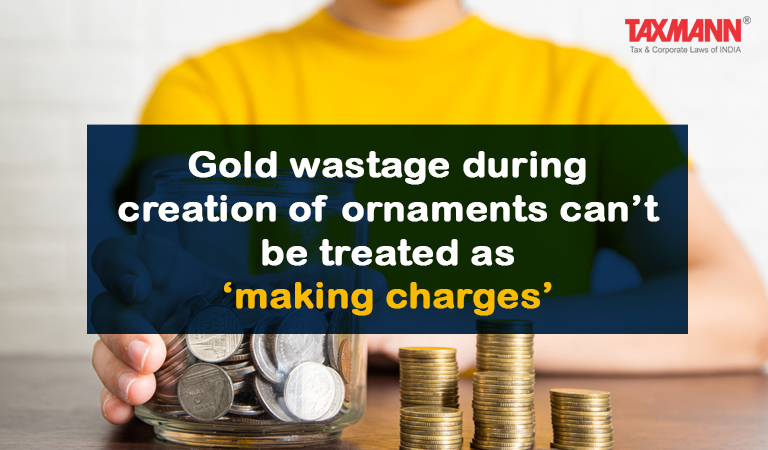Gold wastage during creation of ornaments can’t be treated as ‘making charges’
- Blog|News|Income Tax|
- 2 Min Read
- By Taxmann
- |
- Last Updated on 1 December, 2022

Case Details: P.R. Gold and Silver Craft v. DCIT - [2022] 145 taxmann.com 112 (Chennai-Trib.)
Judiciary and Counsel Details
-
- Mahavir Singh, Vice President & Dr Dipak P. Ripote, Accountant Member
- N. Arjun Raj, CA & S. Sridhar, Adv. for the Appellant.
- Hema Bhupal, JCIT for the Respondent.
Facts of the Case
Assessee was engaged in the business of making gold and silver jewellery. During the relevant year, assessee purchased old jewellery from the customers and the same was melted by the goldsmiths to get pure gold.
During the process of making new ornaments, some gold suffered wastage which was retained by the goldsmiths. During the relevant year, the assessee claimed to have incurred wastages from 5%- 6%.
However, the Assessing Officer restricted the wastage percentage to 1% and contended that the wastage over 1% was to be treated as making charges. AO held that the assessee failed to deduct tax under section 194C on these making charges and made disallowance under section 40(a)(ia).
On appeal, the CIT(A) confirmed the action of AO. Aggrieved-assessee filed the instant appeal before the Tribunal.
ITAT Held
The Tribunal held that the manufacturing of ornaments involves various processes and the wastage is actual and real. However, the given case didn’t pertain to the eligibility of wastage but pertained to whether such wastage was liable to deduction of tax under section 194C.
The entire process of the assessee was it had outsourced its manufacturing to certain jewelers outside Pondicherry and pathars in Pondicherry. The jewelers had not claimed any wastage as loss as they paid higher job charges which includes the value of wastage suffered. However, the pathars claimed wastage but paid lessor job charges.
The assessee filed party-wise details of the making charges paid to jewellers and pathars and details of tax deducted therefrom.
It should be noted that the provisions of section 194C are applicable when the assessee has paid or credited any charges covered thereunder. In case, no payment is debited or credited to the respective party’s account, then such payment cannot be considered within the ambit of section 194C or any other TDS provisions.
In the given case, the claim of wastage whether it is 1% or 6% neither involves any payment nor credit of such sum by way of cash, issue of cheque or draft nor by any other mode. Thus, the deduction of tax at source under section 194C doesn’t arise.
List of Cases Referred to
-
- Siva Valli Vilas Jewellers (P.) Ltd. v. Dy. CIT [IT Appeal No. 3071 (Chennai) of 2017, dated 31-3-2021] (para 6).
Disclaimer: The content/information published on the website is only for general information of the user and shall not be construed as legal advice. While the Taxmann has exercised reasonable efforts to ensure the veracity of information/content published, Taxmann shall be under no liability in any manner whatsoever for incorrect information, if any.

Taxmann Publications has a dedicated in-house Research & Editorial Team. This team consists of a team of Chartered Accountants, Company Secretaries, and Lawyers. This team works under the guidance and supervision of editor-in-chief Mr Rakesh Bhargava.
The Research and Editorial Team is responsible for developing reliable and accurate content for the readers. The team follows the six-sigma approach to achieve the benchmark of zero error in its publications and research platforms. The team ensures that the following publication guidelines are thoroughly followed while developing the content:
- The statutory material is obtained only from the authorized and reliable sources
- All the latest developments in the judicial and legislative fields are covered
- Prepare the analytical write-ups on current, controversial, and important issues to help the readers to understand the concept and its implications
- Every content published by Taxmann is complete, accurate and lucid
- All evidence-based statements are supported with proper reference to Section, Circular No., Notification No. or citations
- The golden rules of grammar, style and consistency are thoroughly followed
- Font and size that’s easy to read and remain consistent across all imprint and digital publications are applied




